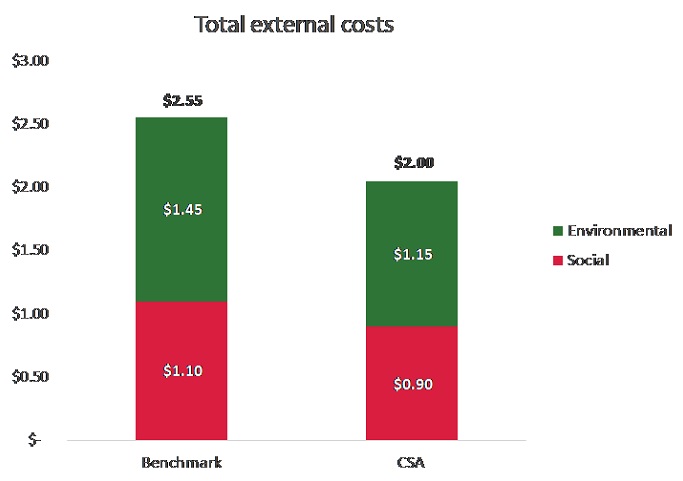These are some of the main recommendations of the latest report on climate-smart coffee in Colombia elaborated by Solidaridad and True Price organization with the support of SAFE Platform and Global Coffee Platform.
New publication defines the cost of coffee
The current international coffee price crisis is affecting the livelihood of thousands of smallholder farmers in the producing countries. Furthermore, the impacts of climate change on the productivity, profitability and resilience of coffee plantations are worsening. With the implementation of Climate-Smart Agriculture (CSA), coffee farmers now have a solution to restore profitability to healthy levels and to minimize the hidden or external costs of coffee production.
In the latest Solidaridad report, The True Price of Climate-Smart Coffee. Quantifying the potential impact of Climate-Smart Agriculture for Colombian coffee (PDF), new insights are drawn from the True Price methodology to define the social and environmental costs of coffee growing, such as water pollution or lack of social security, when included in the pricing of green coffee.
This video also highlights some of the main points of this report:
Two pillars of assessment: price and investment
The report aims to assess the true price of producing CSA coffee in Colombia in order to help make the coffee cheaper for consumers, profitable for the farmer and affordable to all stakeholders across the supply chain.
Two central assessments are that of the true price (of a product) and the true ROI (of an investment). The true price and true ROI allow us to compare different production systems and to identify sustainability issues from a cost-benefit perspective. The report sets out recommendations to reduce the external social and environmental costs of coffee production in hopes of closing the gap between the true price and the market price as much as possible.
The research is based on primary data collected from a group of 60 smallholder farmers in the department of Cauca. One group of participants applied a set of CSA practices while the control group did not. Solidaridad is currently scaling the adoption of Climate-Smart Agriculture in Colombia through the Coffee of the Future programme, in collaboration with private-sector partners and the Federation Nacional de Cafeteros.
Calculating the true price can help manage risks, steer innovations, and reduce social and environmental costs by improving transparency throughout the supply chain of a product. The final goal is to realize affordable and sustainable products: products with a lower true price. – Joel Brounen, Country Manager of Solidaridad in Colombia and co-author of the research
Climate-smart coffee significantly more profitable
In the study, the true price calculation included eight environmental variables in scope (climate change, air pollution, water pollution, soil pollution and degradation, land use/transformation, energy, water and scarce materials use) and three social variables (underearning of smallholder farmers, underpayment and lack of social security of hired workers, and occupational health & safety).
After the analysis of these factors that impact the final price of coffee, the report found two mains results (PDF):
1. External costs of CSA coffee lower than conventional coffee
The researchers found the environmental external costs and the social external costs are around 25% lower in the production of CSA coffee than in conventional. While the external costs of CSA coffee amount to $2.00 USD, the average cost to produce conventional coffee in Cauca is $2.55 USD.

2. Investments in Climate-Smart Agriculture result in a positive Return on Investment (ROI)
The traditional financial metric is Return-on-Investment (ROI), which correlates the benefits of an investment to the required costs, and then shows how well the investment pays off. The True ROI calculation extends the conventional ROI to include external costs and benefits. The higher true ROI for investments in CSA coffee, as found in this study in Colombia, indicates that not only does the farmer profit from the investment but so does society, both in a cost-effective way.
Since the initial expenditure might present a challenge for smallholders, support for farmers is a necessary condition to ensure the outcomes.
The True Price and True ROI methodologies offer main recommendations that can be used by roasters, traders, producers and investors to help scale climate-smart agriculture.
True Price
- Make procurement decisions based on cost-benefit driven models, rather than on compliance-driven models alone.
- Incorporate the costs of increasing climate risks to coffee production in current risk analysis models.
- Increase the awareness of the external costs of coffee production among end consumers.
- Use the true price to optimize the operations and communication activities of value chain stakeholders.
True Return on Investment
- The true ROI analysis shows that investing in CSA can be a more interesting investment to pursue for impact investors.
- Investment frameworks do not consider the positive or negative externalities within their ROI calculations.
- Use the true ROI analysis to improve incentives to farmers and buyers of CSA products.
- Bundle and target public investments in the coffee sector.
The insights from the true price analysis can be used by various stakeholders across the coffee supply chain, such as traders, roasters and consumers, to make pricing decisions.
